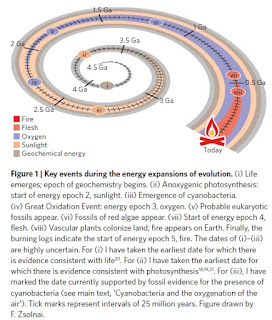Nature Ecology and Evolution has published a fine perspective by evolutionary biologist Olivia Judson on energy availability and evolutionary transitions on earth -
" The history of the life–Earth system can be divided into five ‘energetic’ epochs, each featuring the evolution of life forms that can exploit a new source of energy. These sources are: geochemical energy, sunlight, oxygen, flesh and fire. The first two were present at the start, but oxygen, flesh and fire are all consequences of evolutionary events. Since no category of energy source has disappeared, this has, over time, resulted in an expanding realm of the sources of energy available to living organisms and a concomitant increase in the diversity and complexity of ecosystems. These energy expansions have also mediated the transformation of key aspects of the planetary environment, which have in turn mediated the future course of evolutionary change.Using energy as a lens thus illuminates patterns in the entwined histories of life and Earth, and may also provide a framework for considering the potential trajectories of life–planet systems elsewhere."
Coincidentally, I just finished reading Nick Lane's book The Vital Question, which covers the first three sources of energy discussed in this article. Nick Lane writes about energy currencies of the cell and the constraints it places on the early evolution of life on earth. Why don't bacteria become morphologically larger and more complex?... because there are intrinsic constraints on the energy available for ATP synthesis. You'll have to read Nick Lane's book for a detailed account but Olivia Judson's essay mentions this and more. The other two, animals and fire, encompass the evolution of complex multicellular life and their impact on evolutionary arms races and ecosystem changes.
..and what about life on other planets?..
"As this is the only life–planet system we currently know of, it is impossible to know how representative it is of life–planet systems in general. But if the development of other life–planet systems requires a similar series of energy expansions, the framework presented here suggests a way to anticipate the paths that such systems might take. For instance, if a planet has only geochemical energy— perhaps because it is far from its star, or because it is a nomad and has no star at all—any life present may have “a limited future in terms of the heights it could achieve”. Or suppose a planet is unable to accumulate oxygen. This could happen if living organisms never evolve a way of splitting water to produce the gas in the first place, but even if they do, the planet itself may have characteristics that prevent oxygen from ever building up. Without oxygen, the geological, ecological and evolutionary potential of a life–planet system is likely to be constrained, even if life forms analogous to eukaryotes in their energy-harnessing power (Box 2) were to evolve. Conversely, some planets might be able to accumulate new forms of energy, and life forms able to take advantage of them, much fasterthan Earth has."
Open Access.
" The history of the life–Earth system can be divided into five ‘energetic’ epochs, each featuring the evolution of life forms that can exploit a new source of energy. These sources are: geochemical energy, sunlight, oxygen, flesh and fire. The first two were present at the start, but oxygen, flesh and fire are all consequences of evolutionary events. Since no category of energy source has disappeared, this has, over time, resulted in an expanding realm of the sources of energy available to living organisms and a concomitant increase in the diversity and complexity of ecosystems. These energy expansions have also mediated the transformation of key aspects of the planetary environment, which have in turn mediated the future course of evolutionary change.Using energy as a lens thus illuminates patterns in the entwined histories of life and Earth, and may also provide a framework for considering the potential trajectories of life–planet systems elsewhere."
Coincidentally, I just finished reading Nick Lane's book The Vital Question, which covers the first three sources of energy discussed in this article. Nick Lane writes about energy currencies of the cell and the constraints it places on the early evolution of life on earth. Why don't bacteria become morphologically larger and more complex?... because there are intrinsic constraints on the energy available for ATP synthesis. You'll have to read Nick Lane's book for a detailed account but Olivia Judson's essay mentions this and more. The other two, animals and fire, encompass the evolution of complex multicellular life and their impact on evolutionary arms races and ecosystem changes.
..and what about life on other planets?..
"As this is the only life–planet system we currently know of, it is impossible to know how representative it is of life–planet systems in general. But if the development of other life–planet systems requires a similar series of energy expansions, the framework presented here suggests a way to anticipate the paths that such systems might take. For instance, if a planet has only geochemical energy— perhaps because it is far from its star, or because it is a nomad and has no star at all—any life present may have “a limited future in terms of the heights it could achieve”. Or suppose a planet is unable to accumulate oxygen. This could happen if living organisms never evolve a way of splitting water to produce the gas in the first place, but even if they do, the planet itself may have characteristics that prevent oxygen from ever building up. Without oxygen, the geological, ecological and evolutionary potential of a life–planet system is likely to be constrained, even if life forms analogous to eukaryotes in their energy-harnessing power (Box 2) were to evolve. Conversely, some planets might be able to accumulate new forms of energy, and life forms able to take advantage of them, much fasterthan Earth has."
Open Access.


No comments:
Post a Comment